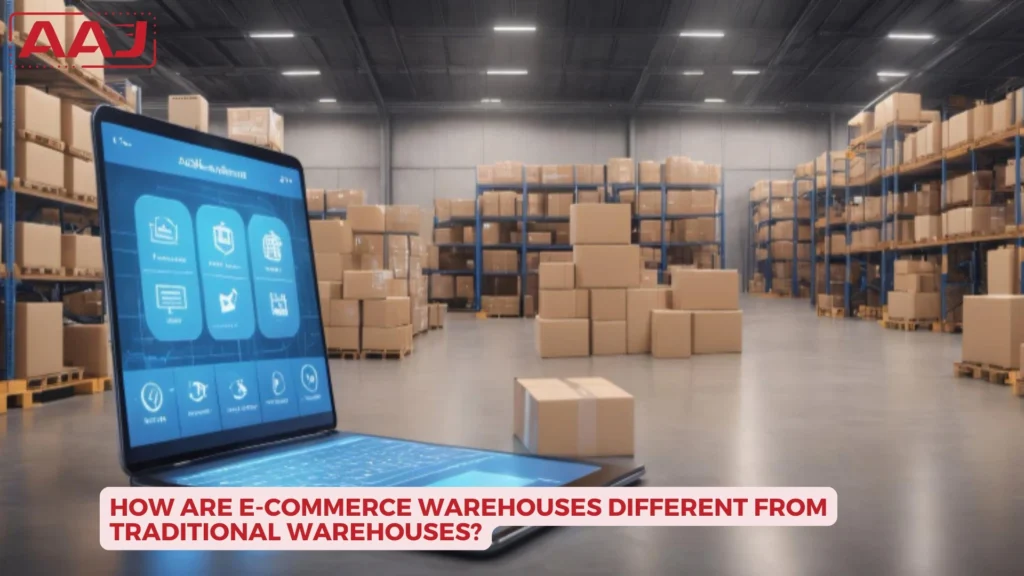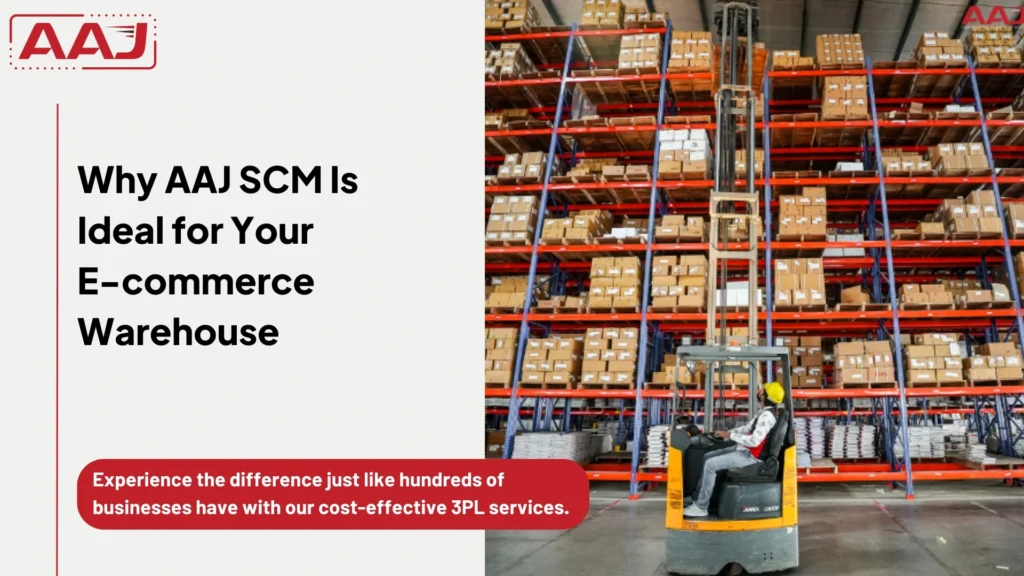In today’s world, items are delivered in minutes. This is all possible because of proper, efficient warehouse management. From small startups to established online stores, all have one thing in common: they have a warehouse for e-commerce stores.
An optimized e-commerce warehouse system defines how much profit you can cash out. That also significantly impacts customer satisfaction, operational costs, and accurate inventory tracking.
Key Components Every eCommerce Warehouse Must Have

You can call an effective warehouse operation the backbone of any E-Commerce business.
Effective features such as the right facility, layout, and equipment can directly impact how your business manages order fulfillment and overall customer satisfaction.
Now, let’s check which eCommerce warehouse solution is best for you.
A. Types of Warehousing Solutions for E-commerce Businesses
- Private warehousing: No other company shares resources with your businesses, which means you have complete control and, at the same time, management responsibility.
- 3PL (Third-Party Logistics): Best for mid-sized businesses, rapidly growing startups, D2C brands, and companies expanding their warehouses in new regions. 3PL companies have the best and latest technologies.
- Dropshipping: Early-stage startups, micro-entrepreneurs, niche product businesses, influencer marketers, and B2B marketplace sellers.
- Cross-docking: This type of warehousing focuses on quick delivery of products rather than long-term storage. Companies requiring this warehousing type include food distribution, grocery, retail chains, and perishable items.
B. What Size and Warehouse Layout Does Your Business Need?
Following are the main considerations that you should focus on when selecting a perfect size and layout for your warehouse.
| Business Category | Recommended Solution | Key Space Allocation | Special Considerations |
| Large E-commerce | Private Warehousing/Hybrid | 15% receiving, 55% storage, 20% packing or shipping, 10% returns | Order accuracy focus, multi-channel fulfillment capability, seasonal scalability |
| FMCG | Private with Cross-Docking | 10% receiving, 60% storage, 20% cross-dock, 10% shipping | Expiration management, promotional handling, and retail compliance requirements |
| Pharmaceutical | GMP-Compliant Private | 10% receiving/QC, 70% controlled storage, 10% staging, 10% shipping | Regulatory compliance, cold chain integrity, lot traceability, and recall management |
| Grocery & Food | Cross-Docking with Cold Storage | 20% receiving, 40% temp-controlled storage, 30% cross-dock, 10% shipping | Food safety compliance, temperature monitoring, and shortened holding periods |
C. Essential Equipment You Need in Your Warehouse
Material handling equipment, such as forklifts, pallet jacks, and conveyor systems, makes an ecommerce warehouse more efficient.
There are four main essential warehousing equipment that any warehouse for ecommerce needs:
- Storage infrastructure: pallet racks, vertical storage and shelving units, and bin systems.
- Picking technologies: Basic paper pick lists, pick-to-light, voice-directed picking, and barcode scanner picking are common.
- Packaging stations: Require proper equipment such as scales, label printers, tape dispensers, and void fill systems.
- Safety Signs and Warning: Proper lighting, floor marking, and danger/not-to-touch or not-to-enter signs.
D. Inventory Tracking Systems
Most modern warehouses for ecommerce provide two main data points any online store needs: first is the real-time visibility into stock levels, and second is their tracking and movements in inventory.
Here are a few changes that you should implement in your ecommerce warehouse:
- Use barcode scanners and RFID systems for quick, accurate product counts and identification.
- Use a central dashboard control system, i.e., a Warehouse Management System (WMS), for comprehensive inventory control.
- Use the WMS logistic company warehouse that offers features such as:
- Location tracking
- Batch management
- Serial number tracking
- Must have a cloud-based inventory platform that can be remotely accessed for your supervision and management.
E. Stock Replenishment Strategies for Your E-commerce Warehouse
The best stock replenishment strategy prevents any stockouts and minimizes your warehousing costs. Here are a few pointers you should focus on:
- Economic Order Quantity (EOQ) is Used to calculate the optimal order sizes based on demand patterns, holding costs, and ordering costs.
- Just-in-Time (JIT) inventory is majorly used to predict future high demands of the product, such as seasonal products based on previous years sales data and current marketing trends.

The safety Stock Factor formula is used to protect against supply chain disruptions.
| Safety Stock Factor | Application Scenario |
| Low (1-2 days) | Stable suppliers, predictable demand |
| Medium (3-7 days) | Some variability in the supply chain |
| High (8-14+ days) | International shipping, volatile demand |
F. Proper Safety and Regulatory Compliance in Your Warehouse
An e-commerce warehouse must have essential safety equipment and trained personnel with proper instructions on what to do in specific emergencies.
Essential Safety Equipment:
- Personal protective equipment (PPE) includes hard helmets, safety footwear, and high-visibility clothing (possibly yellow).
- Fire extinguishers must be placed at an easily managed height and in strategic locations.
- First aid kits and emergency eyewash solutions.
- Guard rails and safety gates around elevated platforms.
Moreover, each warehouse must be audited regularly to identify any potential hazards before accidents occur.
On top of it, there are some more regulatory certifications that increase the credibility of a warehouse company.
Some of the key compliance areas are:
| Regulation Type | Example Standards |
| Fire Safety | NFPA standards, sprinkler requirements |
| Building Codes | Load capacity, structural integrity |
| Environmental | Waste disposal, emissions control |
How Are E-Commerce Warehouses Different From Traditional Warehouses?

The main difference between e-commerce and traditional warehouses lies in their core purposes of order fulfillment.
- Traditional warehouses focus on efficient B2B warehouse storage and B2B distribution.
- Meanwhile, e-commerce warehouses prioritise rapid direct-to-consumer D2C fulfilment.
| Feature | E-commerce Warehouses | Traditional Warehouses |
| Primary Function | Direct-to-consumer fulfillment with individual orders | B2B distribution with bulk shipments |
| Order Profile | High volume of small orders with rapid processing (hours/same-day) | Lower volume of large orders with scheduled delivery (days) |
| Layout & Space | Optimized for picking efficiency with more floor space for processing | Designed for storage density with vertical space maximization |
| Technology Integration | Extensive integration with multiple platforms (e-commerce sites, marketplaces, CRM) | Basic inventory management is connected primarily to ERP systems |
| Inventory Management | Item-level tracking with high-frequency turns and real-time updates | Case/pallet tracking with lower-frequency turns |
| Returns Processing | Dedicated area with high-volume capability and specific protocols | Minimal processing with limited protocols |
| Shipping Approach | Multiple carriers with varied service levels and parcel focus | Limited carriers focused on freight and scheduled deliveries |
| Automation Level | Often high with conveyors, sorting systems, and picking robots | Moderate to low with a focus on material handling equipment |
| Staffing Requirements | Larger teams with digital system skills and scaling during peak seasons | Consistent staffing focused on equipment operation and inventory control |
| Value-Added Services | Gift wrapping, kitting, personalization, custom packaging | Minimal customization beyond basic palletizing and labeling |
Benefits of Outsourcing the Warehouse for Ecommerce

- A company can focus on its core business by outsourcing warehouse logistics and avoid any management-related issues in in-house management.
- Reduces the upfront investment required in warehouse facilities, technologies, and managing specialized staff.
- Most reputable logistics companies in India offer inventory management systems, order processing software, and predictive analytics to their partners.
- Scalability can be easily done based on storage space and fulfillment requirements during seasonal peaks or rapid demand for a product.
- It is easy to partner with a logistics warehouse solution and extend your network coverage with that geographic expansion without setting up your own warehouse.
- Specialized expertise is required for efficient warehouse management. This includes handling a specific product type, stacking type, oversized products, and inventory management. A warehouse company for ecommerce does all of this fraction of the cost compared to setting up your own warehouse.
Challenges Faced in an eCommerce Warehouse & Fulfillment Center

The following are some of the challenges that an e-commerce warehouse company might face.
1. Accurate Inventory Management: The most important factor in any warehouse system is maintaining accurate stock levels; even a single error or stock entry can cause inaccurate stock counts in your online store.
2. Reduce errors in picking and packing, and as per some reports, it can lead to up to 5% of returns, impacting customer satisfaction and increasing logistic costs.
3. Managing fast scaling of demanding products during peak seasons such as Indian Diwali sales without compromising service quality and delivery time.
4. Space Optimization: Finding the inefficiencies in space layouts caused by growing product catalogues. This all slows down the picking processes and, at the same time, elevates labor costs.
5. Returns Processing: The higher the return, the higher the financial burden on businesses, which also adds extra complexity and expenses.
6. Labor Management: challenges such as high training costs, productivity tracking, turnover rates, and safety concerns within the workforce.
7. Technology Integration: Using outdated technology and legacy systems can create data silos and disrupt the seamless operations.
8. Last-mile delivery: Coordination with multiple carriers in terms of tight delivery windows like same-day or next-day delivery.
Best Strategy to Optimize Warehouse for eCommerce Business

1. Layout Optimization: Every product should be arranged based on its sales velocity. The rule of thumb is that one should keep fast-moving items near the packing station to reduce the picking time.
2. Technology Utilization: Use a real-time inventory system (such as WMS) to track real-time visibility in stock levels and item location within the warehouse. The system should also predict demand patterns and automate reordering to prevent situations such as overstock and stockout.
3. Picking and Packing Efficiency: Train and employ efficient picking and packing strategies, including:
- Batch picking for multiple orders simultaneously.
- Zone picking for large warehouses.
- Wave picking during a specific time period.
- Technologies like pick-to-light or voice-directed picking.
4. Regular Employee Training: Proper Staff Training ensures that workers know how to handle different types of inventory. Employ best practices such as cross-training to enhance flexibility during peak periods.
5. Regular Performance Monitoring: Performance Metrics should be established and monitored regularly:
| Metric | Description | Target |
| Order Accuracy | Percentage of error-free orders | >99% |
| Picking Speed | Items picked per hour | Industry dependent |
| Inventory Turnover | How quickly does inventory sell | Higher is better |
| Order Cycle Time | Order receipt to shipment | <24 hours |
6. Automate Operations: Investing in making warehouses for ecommerce more automated can increase throughput and accuracy in handling and picking. Conveyor systems, automated storage and retrieval systems (AS/RS), and robotic picking are some of the automated fulfillment solutions that every modern big warehouse should look for.
How to Choose the Ecommerce Warehouse and Fulfillment Center?

Selecting the right warehouse for ecommerce business can decrease your warehouse and transportation cost by at least 20%. The following are some of the e-commerce warehouse requirements that you must follow:
1. Location Strategy:
You should choose a warehouse location that is close to your primary target customer or region. For example, if your target customers are from tier 3 cities, choosing a warehouse from tier 3 or at least tier 2 regions is better.
Multiple fulfillment centers can be used at different locations in a city to minimise the shipping cost and delivery time. This same principle is followed by a 10-minute delivery ecommerce store.
Another factor is the easy access to major transportation routes, such as major highways, ports, or airports, to decrease shipping time.
2. Warehouse Capabilities:
Space requirements: If you’re a growing business, you must book a warehouse with 10-20% more space than your current needs. This will help to manage seasonal demands as well as returned orders.
Other key warehouse features to evaluate are:
- Loading dock accessibility
- Security systems
- Climate control options
- Technology infrastructure
- Scalability potential
3. Operational Excellence:
- Accuracy rates: The picking/packing accuracy should be more than 99%.
- Processing times: Discuss about order-to-ship time and the capacity a warehouse can handle during peak hours.
- Returns processing: Check return handling procedures and reconditioning capabilities
- Real-time visibility: Remote access to data such as inventory levels and order status from an online platform.
Note: Don’t compromise on safety compliance over cost. Ensure your warehouse for ecommerce meets all the safety codes and relevant industry-specific regulations.
Why AAJ SCM Is Ideal for Your E-commerce Warehouse

AAJ has 9 warehouse locations that are situated in major cities such as Delhi, Mumbai, Bangalore, Hyderabad, Kolkata, Ghaziabad, Sonipat NCR, and Haryana NCR.
Strategic Infrastructure
- All 12+ lakh sq. ft. warehouse space is strategically located all over Pan-India.
- Minimal Out of Delivery Area (ODA) ensures a wider market reach.
Technology-Driven Operations
- AAJ offers a 100% transparent and real-time analytics dashboard to give our partners complete visibility into inventory and shipments.
- You can track your shipment from the order to its delivery anytime.
- Our automated transport selection system offers minimal cost and delivery speed for each order we ship from our warehouse.
- Digital POD (Proof of Delivery) system with 1-7 years of accessible documentation.
Performance Advantages
- We guarantee 90% on-time delivery that increases your brand image and offers better customer satisfaction.
- There is no charge hike as per demands and competitive transportation rates.
- One-stop solution with our single point of contact for streamlined communication and issue resolution
Operational Simplicity
- Our platform provides a streamlined booking interface for your warehouse spaces and inventory.
- Detailed freight invoices with a transparent breakdown of all charges
- Multiple carrier integrations provide more flexibility in managing the delivery time.
In contrast to the majority of the traditional warehousing service approach, we at AAJ Supply Chain Management provide a modern logistics and warehouse solution backed by technology with cost-effective 3PL solutions. So, contact us right now and start your journey with us.




